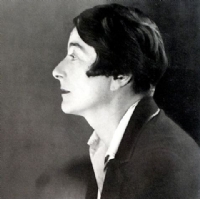
Eileen Gray
Irish and aristocratic by birth, Eileen Gray was trained at the Slade School of Fine Arts of London and in 1902 she moved to Paris. With her extraordinary, creative and unusual personality, she represented the "new woman" of the 1900s: she wore her hair "like a man," she smoked in public, drove a car, and flew in an airplane. She had romances with men and women and went to restaurants and nightclubs with them, even wearing men's clothing. She honed her own sensitivity as an artist among some of the major cultural figures of the age: Colette, Gide, Proust, Rilke, Joyce and Gertrude Stein. The independence and the originality of her thinking made her career entirely unique. In 1922, she opened a gallery with furniture, lamps, mirrors and carpets that she produced in small quantities. After her success as an interior decorator, and after turning 40, she studied architecture. From Art Deco, she migrated towards the Modern Movement, leaving an indelible influence on the history of 20th century design. Her house "E 1027" in Cote d'Azur (1927-29) was famous: an emblem of architecture from the 1900s, a monument to Gray's modernist vision.
Furniture designed by Eileen Gray

